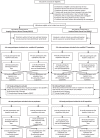NPWT resource use compared with standard moist wound care in diabetic foot wounds: DiaFu randomized clinical trial results
- PMID: 36180953
- PMCID: PMC9524075
- DOI: 10.1186/s13047-022-00569-w
NPWT resource use compared with standard moist wound care in diabetic foot wounds: DiaFu randomized clinical trial results
Abstract
Background: Diabetic foot ulcers not only have a negative impact on patient mortality, morbidity and quality of life, but also require high resource utilization to achieve complete wound healing. The aim of this evaluation was to compare resource utilization of negative pressure wound therapy (NPWT) and standard moist wound care (SMWC) for diabetic foot wounds after amputation, surgical debridement or wound cleansing.
Methods: The multicenter clinical DiaFu study enrolled 368 adults with diabetic foot ulcers between December 23, 2011 and October 21, 2014. Patients were randomly assigned to NPWT and SMWC. Evaluation of direct resource use comprised inpatient and outpatient treatment time, and personnel and material for wound treatment within 16 weeks. This resource use analysis was primarily based on the per protocol population (NPWT 44; SMWC 110).
Results: Treatment duration was 16 days shorter with NPWT (mean (SD) 82.8 (31.6), SMWC 98.8 (24.6); U test, p = 0.001) with 14.9 days shorter outpatient treatment (mean (SD) NPWT 68.3 (31.1), SMWC 83.2 (29.7)). The number of dressing changes per study participant was lower with NPWT (mean (SD) 35.1 (18.6), SMWC (42.9 (21.4); U test, p = 0.067). Time per dressing change was significantly lower with SMWC (mean (SD) 19.7 (12.8), NPWT (16.5 (8.2) minutes; U test, p < < 0.0001). Time for surgical debridements per study participant was 23.3 minutes shorter with NPWT (mean (SD) 20.5 (20.5), SMWC (43.8 (46.7); U test, p = 0.395).
Conclusions: Resource use was lower for NPWT, which may be an efficient treatment alternative to SMWC for diabetic foot wounds, to be demonstrated in subsequent cost analyses.
Trial registration: clinicaltrials.gov NCT01480362 on November 28, 2011.
Keywords: Diabetic foot; Negative pressure wound therapy; Resource use; Wound; Wound care.
© 2022. The Author(s).
Conflict of interest statement
The German statutory health insurance companies commissioned the Witten/Herdecke University (UW/H) to plan, conduct, analyze and publish the study. DS was an employee of the UW/H. RL is an employee of the UW/H. The study has been financed by the manufacturers KCI (Acelity) and S&N. DS received a consulting fee for the presentation of the study during an event organized by the manufacturer Hartmann. All clinical investigators received a case fee for each patient included in the DiaFu study in order to compensate for the additional organizational and especially the documentation effort during trial conduct. Furthermore, all investigators received compensation for travelling to the investigator meetings. The institutions of the investigators used integrated care contracts for NPWT during study conduct in order to provide best practice for the study participants during outpatient care.
Figures


References
-
- International diabetes federation, DIABETES ATLAS 2019, IDF: https://diabetesatlas.org/.
-
- Probst S, et al. EWMA document: home care-wound care: overview, challenges and perspectives. J Wound Care. 2014;23(Suppl 5a):S1–S41. - PubMed
Publication types
MeSH terms
Associated data
Grants and funding
LinkOut - more resources
Full Text Sources
Medical

